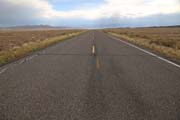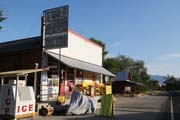Great Basin National Park, located in eastern Nevada. protects a remnant ice
field on Wheeler Peak, ancient bristlecone pine forests, and decorated galleries
of Lehman Caves. A geographic region of the American West (from
California's Sierra Nevada to Utah's Wasatch Mountains), the Great Basin is
defined in geologic terms and hydrologic boundaries that precious water draining
from the mountain ranges does not flow into the oceans. Although only a
small part of this immense, wild land, Great Basin National Park is undoubtedly
the best example of the entire Great Basin region. Lehman Caves National
Monument was created by presidential proclamation on January 24, 1922, and
it was incorporated into the national park on October 27, 1986 including much of
the South Snake Range.
Getting there ...
 |
We had a flight to Salk Lake City,
and got a rental car for the 4-hour (234 miles) drive. The section
of Route 50 in Utah passes through desolate, remote areas where we
seldom saw other cars in either directions (the Nevada section was
named The
Loneliest Road in America by Life magazine in July 1986).
We arrived in Baker just before 5PM and had a quick visit to the visitor
center before it closed for the day. Baker is an unincorporated
community in Nevada, with a population of 68 in 2010 census. It
has a very simple main street (with 2 restaurants/grocery stores/hotels,
1 post office, 1 gas station,...) and basic lodging (the room sign says:
you are in Baker, not in Paris...). |
 |
- After a short break, we headed into the park to Mather Overlook.
It had very nice views along the Wheeler Peak Scenic Drive; however, it did
not have many turnouts for us to stop to enjoy the views (in fact, I think
there is only one reasonable turnout before the Mather Overlook near a
180-degree turn).
Linus and Iris enjoyed the cool air
during the ride at the high mountains like kids...
Day 2 (7/30) ...
- Bristlecone Pine Grove, Wheeler Peak
The Great Basin bristlecone pine
trees from California and Nevada are the oldest known living trees (or
living things) in the world. In 1964, a living bristlecone pine tree
(named as Prometheus) in the Wheeler Peak grove was cut down for research
purposes. Counting the rings later revealed that Prometheus contained
4,862 growth rings. Due to the harsh conditions these trees grow in, it is
likely that a growth ring does not form every year. Because of this,
Prometheus was estimated at being 4,900 years old, the oldest known tree of
its time (It wasn’t until 2012 when another bristlecone from the same area
proved to be 5,065 years old).
The trail to the grove is 2.8-mile round
trip with gentle ascend of 600 feet. Although it was not a strenuous hike,
Iris did not feel too well
(headache + stomach ache + maybe high altitude sickness, being above 10,000
feet) that she walked slowly and I had to stay with her and pull her up from
time to time.
- Teresa Lake
My original plan was to use Alpine Lakes Loop trail to go
through Lake Teresa and Stella Lake. However, when we started to hike
down from the Bristlecone Pine Grove, it was getting cloudy and we could
hear thunder in the distance, and it began to rain by the time we reached
Teresa Lake. We decided to return and had to walk fast (almost
running) back to the parking lot at Wheeler Peak campground to dry ourselves
up and to have a
picnic lunch under a covered gazebo at the trailhead.
One thing we
learned from this trail: Pokémon Go will not hatch if there is no
network...
- Back Down to Lehman Caves Visitor Center
- Baker Archaeological Site & Sunset
The Baker Archaeological Site,
also known as Baker Village, contains the remains of a Fremont
Indian village occupied from approximately 1220 to 1295 AD. The site
was excavated by BYU from 1991 to 1994. After the excavations, the
site was backfilled (reburied with the dirt that was removed during
excavation), a necessary step in protecting the cultural features that
remain. As a result, the foundations of the village can no longer be seen on
the surface (in fact, you won't be able see anything at all...).
Linus
and Iris took a break to stay in the hotel room. Only Woanyu was nice
enough to come with me (since there were some Pokémon Stops...).
Day 3 (7/31) ...
- Lehman Caves
Lehman Caves, known for centuries by local tribes and
"discovered" by Avsolom Lehman in 1885, extends a quarter-mile into the
limestone and marble that flank the base of the Snake Range. The
temperature in the cave is a constant 50° F (10° C) year round. A
visit through the caverns is a subterranean adventure into a cool, damp
world of darkness and silence. Crystalline formations of calcite range
from delicate helicites to stately stalactites, stalagmites, and columns
with hundreds of thousands of years.
Salt Lake City ...
It was a long drive back to Salt Lake City.
Linus volunteered to drive the first leg
from Baker to Delta (~ 100 miles) so he would not get too bored in the car.
After the lunch at a McDonald's (with a huge playground which is useless to us
now) in Delta, I took over to drive all the way to Temple Square in Salt Lake
City.
The city was founded in 1847 by Brigham Young, and numerous
other Mormon followers. Home to the headquarters of The Church of Jesus
Christ of Latter-day Saints (LDS Church) and Temple Square, Salt Lake City is
historically considered a holy city by members of the LDS church.
The construction of the Salt Lake Temple started in 1853, and it took 40 years
to finish in 1893. The temple has become an icon for the city and serves
as its centerpiece.
Going Home ...
 |
We had a good dinner at an Oliver
Garden a few blocks from Temple Square (Oliver Garden has been one of
our favorite for more than 20 years and we have been missing it since
they closed the one in Palo Alto a few months ago). Although it
was only a short 3-day trip, and although Great Basin is not the most
popular national park (it was ranked 49th out of 58 US national parks in
number of visitors in 2015), it was still good to get touch with the
nature, enjoy the solitude of sunrise/sunset moment, and have some good
quality family time. |
[Back to Photo Page]
[Gallery]